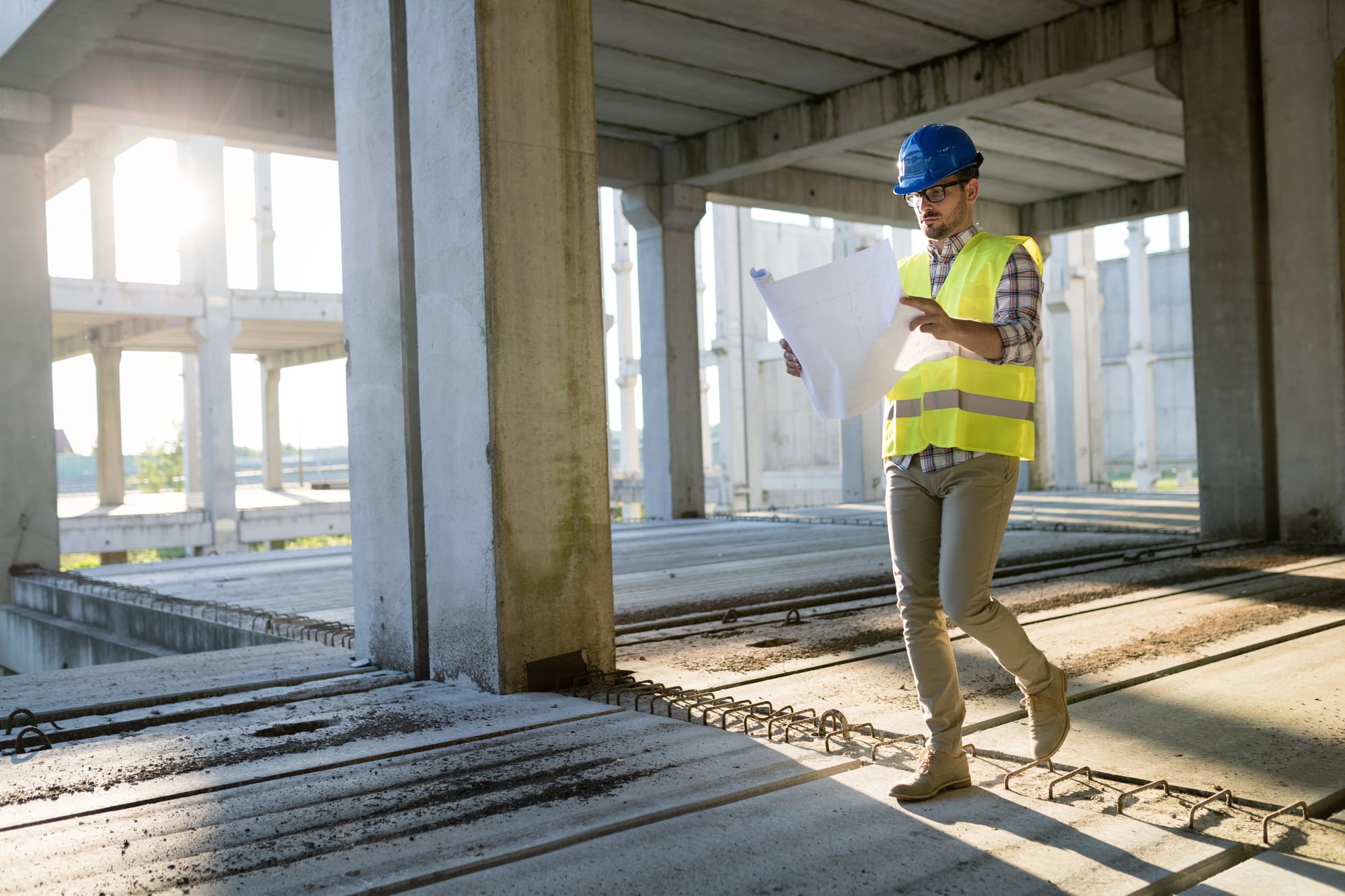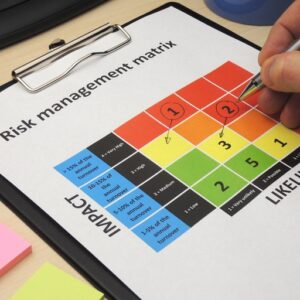Mastering Risk Assessment: Your Ultimate Guide to Identify and Mitigate Potential Risks

Are you tired of feeling like you’re constantly putting out fires in your business? Do you wish you could identify potential risks before they become major problems? Risk assessment is a crucial skill for any business owner or manager to master.
In this article
What is risk assessment?
Risk assessment is a crucial practice that helps businesses identify hazards and evaluate potential risks. By following a systematic approach, organizations can analyse and evaluate safety and health risks associated with specific activities or operations.
The goal of risk assessment is to assist organizations in preparing for and combating risk by identifying hazards and taking proactive steps to control them. A well-conducted risk assessment can provide numerous benefits, including:
- Lowering the likelihood and severity of incidents
- Reduced insurance premiums
- Improved legal and regulatory compliance
- Enhanced safety and well-being of employees and the public
It is crucial for businesses to conduct risk assessments regularly, particularly when new activities or processes are introduced. By properly assessing the risks of their business, organisations can make informed decisions regarding risk reduction and management. This is an ongoing process that allows businesses to identify potential hazards and evaluate the level of risk they pose. It helps organizations make informed decisions on risk control measures and can provide significant benefits to safety, legal compliance, and business operations.
Why is risk assessment important?
Implementing a risk assessment process can provide numerous benefits to organisations, from increased safety and well-being of employees to reduced insurance premiums and regulatory compliance. By identifying and dealing with potential hazards, businesses can minimise the possibility of workplace injuries, illnesses, and fatalities. Risk assessment also helps companies ensure they meet regulatory requirements and can prevent costly legal penalties.
Developing a proactive approach to risk management can help businesses be better prepared to handle any risks that might arise in the future.
How do you conduct a risk assessment?
It involves the identification, analysis, evaluation, and treatment of potential hazards and risks in the workplace. A well-structured risk assessment process can help an organization identify and prioritize risks, and implement appropriate controls to deal with them effectively.
In Australia, it is recommended to follow the five steps suggested in the Australian Standard AS/NZS ISO 31000 Risk Management for conducting a risk assessment.
Step One: Establishing the Context
The first step is to establish the context. This involves defining the scope and objectives of the assessment, identifying the internal and external factors that could affect it, and developing a risk management plan. It is essential to involve the relevant stakeholders in this process.
Step Two: Identifying the Risks
The second step is to identify the risks by searching for potential hazards, analysing the causes and potential consequences of each risk, and determining the likelihood and severity of those consequences. This step requires a systematic and thorough approach and involves obtaining input from all relevant stakeholders.
Step Three: Evaluating the Risks
The third step involves the evaluation of the risks found. This requires comparing the risks to pre-established risk criteria, assessing the effectiveness of existing controls, and considering the acceptability of the remaining risk. The evaluation process should include both quantitative and qualitative analysis.
Step Four: Treating the Risks
The fourth step involves treating the risks. This means selecting and implementing appropriate controls to reduce or eliminate those risks and monitoring and reviewing those controls over time. Treatment options may include elimination, substitution, engineering controls, administrative controls, and personal protective equipment.
Step Five: Communicating and Consulting with Stakeholders
The final step is to communicate and consult with stakeholders throughout the process to ensure a shared understanding of the risks and the controls implemented. This step is vital to ensure effective risk management and to maintain the engagement and support of all stakeholders.
A thorough and structured process can help organisations identify and prioritize risks effectively, implement controls to mitigate them, and maintain a safe and healthy workplace. By following the five steps suggested in the Australian Standard AS/NZS ISO 31000 and involving all relevant stakeholders, a comprehensive and effective risk assessment can be achieved.

What are the common challenges in risk assessment?
Here are some challenges and solutions on how to address them.
Lack of knowledge or experience among risk assessors.
Inadequate understanding of the hazards and risks involved can lead to incomplete or inaccurate assessments, which can result in potential harm to workers and disruption in business operations. To address this challenge, it is crucial to provide adequate training and education for risk assessors, particularly those who are new to the process. This can include workshops, seminars, and online resources that cover the basics of risk assessment, including hazard identification, risk analysis, and control measures.
Pressure to meet production deadlines, which can lead to rushing through the assessment or skipping important steps.
This can result in incomplete assessments that fail to identify potential hazards and risks. To avoid this challenge, it is essential to establish a risk assessment plan that includes timelines, milestones, and key deliverables. This plan should be communicated to all relevant stakeholders, including management and workers, to ensure that everyone is aware of the expectations and deadlines.
Lack of resources is another common challenge in risk assessment.
Limited budgets or staff can impact the quality and effectiveness of risk assessments, as there might not be enough resources available to conduct a comprehensive assessment. To address this challenge, it is essential to allocate sufficient resources for risk assessment activities, including funds for equipment, training, and personnel.
To overcome these challenges, it is crucial to continuously evaluate the effectiveness of the control measures. This allows the organization to monitor the progress made towards reducing risks and ensure that the measures are achieving the desired outcome. Additionally, consulting with experts and stakeholders who have experience in risk assessment can provide valuable insights into ways to overcome specific challenges unique to the workplace.
What are the benefits of risk assessment in business?
Conducting risk assessments helps businesses identify and manage potential hazards, prevent incidents from occurring, meet legal requirements, create awareness about risks, and increase overall productivity. Let us delve into some of the significant benefits of risk assessment in business.
Prevent incidents
Identifying risks allows businesses to prevent incidents before they occur, helping to safeguard staff, customers, and visitors from harm. It also helps businesses to comply with legal requirements for safety and health and mitigate the adverse effects of catastrophes on their operations.
Risk mitigation
Risk assessments are an effective means of creating awareness among employees and other stakeholders about the risks associated with their environment. These assessments provide an overview of the potential hazards and how to avoid them, thereby reducing risks and promoting a culture of safety and participation.
Determining worth of assets
The process of risk assessment also helps businesses to inventory assets accurately, determining the worth of each asset and its contribution to the overall performance of the business. By taking stock of the assets, businesses can better understand which assets require the highest level of protection, directing resources into the most needed areas.
Allocate resources
Application of risk assessments help businesses determine the budget needed for risk mitigation by identifying the specific risks that exist and what can be done to prevent them from happening. This helps to allocate resources more effectively and ensures that the right amount of resources are available for successful mitigation of risks.
In conclusion, conducting risk assessments has numerous benefits for businesses. By identifying potential hazards, creating awareness of risks, complying with legal requirements, inventorying assets, understanding the return on investment, and determining budget for risk mitigation, businesses can significantly improve the safety of their workplace while also increasing overall productivity.
How can risk assessment help in decision-making?
Risk assessment is a critical aspect of decision-making, particularly within industries that have inherent risks, such as construction, healthcare, and manufacturing. By considering potential hazards and risks associated with a particular decision, it can provide a structured approach to determine the likelihood and severity of potential risks, which can assist organisations in making informed decisions.
One of the most crucial benefits of risk assessment is that it helps organizations to weigh the risks against the benefits of a particular decision. This involves assessing the potential outcomes and considering the impact of the decision on stakeholders, including staff, customers, and the general public. Through risk assessment, a business can analyse a range of options to determine the best course of action, taking into account the risks and potential hazards of each option.
Additionally, risk assessment helps organizations to establish risk reduction policies and procedures. This involves identifying the measures that can be taken to mitigate risks and reduce the likelihood of an incident occurring. By having a structured approach to risk, organizations can ensure that all possible avenues for avoiding or minimizing risk are explored before making decisions.
To effectively use risk assessment in decision-making, it is important to consider the level of risk associated with a particular decision, potential hazards, and existing risk reduction policies, among other factors. For instance, if a business needs to decide whether to implement a new safety protocol, risk assessment can be used to consider the potential hazards of not implementing the protocol and the likelihood of incidents occurring in the absence of the protocol.
Ultimately, risk assessment provides a powerful tool for organisations looking to minimise risks and make informed decisions. By using a structured approach to analyse risks and potential hazards, businesses can identify the optimal course of action to ensure the safety of their employees, customers, and other stakeholders.

What tools and methodologies are used in risk assessment?
Risk assessment is a crucial process that helps organizations to manage potential risks and hazards effectively. It involves identifying, analysing, evaluating, and prioritizing risks and developing strategies to mitigate or reduce their impact. To do this, various tools and methodologies are used in the risk assessment process. In this article, we will explore some of the commonly used tools and methodologies in risk assessment.
One widely used methodology is Hazard Identification and Risk Assessment (HIRA), which involves identifying and assessing potential hazards in a given environment. This process typically involves the use of safety experts who assess potential hazards and determine the likelihood of those hazards causing harm. HIRA also involves evaluating the potential impact of such hazards and prioritizing the risks and potential hazards along with the available control measures.
Another commonly used methodology is Failure Modes and Effects Analysis (FMEA), which is used to identify and analyse potential failure modes in a system. FMEA helps organizations to analyse the effects of failure and determine the likelihood of a failure occurring. This approach helps identify the root cause of the potential failure and helps in developing controls to mitigate the risks.
Other tools and methodologies used in risk assessment include checklists, SWOT analysis, and risk matrices. Checklists allow for a more straightforward approach to identify and assess hazards. It provides a list of potential hazards in a given environment or process that can be checked off to assess the severity of the hazard. SWOT analysis is an approach that helps organizations to identify their strengths, weaknesses, opportunities, and threats in a given environment. It can be used to identify potential risks and hazards that may arise from change in product, project, environment, etc. Finally, risk matrices provide a visual representation of the severity of risks and hazards. This tool combines the likelihood and potential impact of a risk or hazard to generate a risk score that indicates the level of risk associated with that hazard.
View our checklists to help you identify and assess workplace hazards.
Browse our selection of templates now and take the first step towards creating a safer and healthier workplace for you and your employees.
-
 Workplace Inspection Checklist$29.95 (ex. GST)
Workplace Inspection Checklist$29.95 (ex. GST) -
 Vacant Property Protection Checklist$29.95 (ex. GST)
Vacant Property Protection Checklist$29.95 (ex. GST) -
 Property Risk Inspection Checklist$29.95 (ex. GST)
Property Risk Inspection Checklist$29.95 (ex. GST) -
 Facility Security Assessment Checklist$29.95 (ex. GST)
Facility Security Assessment Checklist$29.95 (ex. GST) -
 EPS Inspection Checklist$29.95 (ex. GST)
EPS Inspection Checklist$29.95 (ex. GST) -
 Contractor Induction Checklist$29.95 (ex. GST)
Contractor Induction Checklist$29.95 (ex. GST)
What is the role of risk assessment in project management?
A risk is any uncertain event or condition that, if it occurs, could have either positive or negative effects on the project objectives. Therefore, identifying potential risks helps project managers to prepare better for any eventualities, create contingency plans, and ensure the project’s overall success.
One way to ensure that all risks are accounted for is by creating a risk management plan. This plan is developed in conjunction with the project plan and outlines strategies and action plans for addressing each identified risk. The risk management plan establishes the overall approach to be used for risk management and includes risk identification, analysis, evaluation, monitoring, and control procedures.
The risk assessment process consists of four main steps: risk identification, risk analysis, risk evaluation, and risk response planning. The first step, risk identification, involves identifying possible hazards or risks that may have an impact on the project. Once identified, the risks are analysed in detail to ascertain their likelihood and potential impact. This step is called risk analysis, where the identified risks are evaluated based on their respective likelihood of occurrence and potential impact on the project’s objectives. Following this, project stakeholders evaluate the risks, considering the extent of the potential consequences and their respective probability of occurrence. This step in the process is called risk evaluation.
The final step in the risk assessment process is risk response planning. This step involves developing strategies, procedures, and contingency plans to mitigate the identified risks. Risks can be responded to in different ways, including avoidance, transference, mitigation, and acceptance.
The risk assessment process does not end with the response planning stage of the project. Risk management is an ongoing process that requires continuous risk monitoring and control throughout the project lifecycle. Regular updating of the risk management plan should be done to ensure all risks are accounted for and appropriate adjustments made to the response strategies.
What is the connection between risk assessment and insurance?
Risk assessment and insurance are interconnected in important ways. One of the primary roles of insurance is to provide financial protection in the event of a risk becoming a reality. This financial support can help businesses or individuals to recover more quickly from an accident or incident.
To effectively provide coverage, insurance companies need to evaluate the level of risk associated with a particular situation. This is where risk assessments come in. When a business or individual applies for insurance, the insurance company will often require a risk assessment to be conducted. This can help identify potential hazards or risks and assess the likelihood of them happening.
Based on this information, insurers can adjust their premiums to reflect the level of risk involved. For example, if a business operates in a high-risk industry, such as construction, their insurance premiums may be higher than those of a business in a lower-risk industry, such as accounting. The risk assessment helps the insurance company set an appropriate premium for the level of financial protection required.
Risk assessments are also an important tool for businesses when deciding what type of insurance coverage to purchase. For example, a risk assessment could highlight the need for workers’ compensation insurance if there are identified workplace hazards that could result in employee injury. Additionally, the risk assessment can determine what the appropriate level of coverage should be. Higher risk businesses may require more coverage than those with lower risk.
Insurance and risk assessment also overlap when it comes to identifying potential sources of liability. A thorough risk assessment can help identify hazards that could result in legal action against a business, for example, if someone is injured on their property. By identifying potential sources of liability, businesses can ensure they have the right level of insurance coverage to help manage any associated financial risks.
Finally, insurance and risk assessment work together when evaluating the financial impact of a risk. If a risk becomes a reality, the insurance payout can help to reduce the financial impact on the business or individual. However, the payout needs to be enough to cover all associated costs. A risk assessment can help determine the potential financial impact of a risk, which can then inform the level of insurance coverage required.
In summary, risk assessment and insurance are closely connected. Risk assessments can help insurers set appropriate premiums, businesses identify the appropriate coverage needed, and evaluate the financial impact of risks. Insurance, in turn, can provide financial protection and be used as a risk control to mitigate the impact of a potential hazard.

How can risk assessment be used to enhance workplace safety?
Risk assessment is a vital tool in enhancing workplace safety, as it helps identify workplace hazards and evaluate their risks. The process involves identifying potential hazards in the workplace by thoroughly examining the work area and processes. Once identified, the hazards are then assessed for severity and likelihood, and appropriate control measures are implemented to reduce the risk of harm.
To effectively identify hazards at work, the first step is to involve workers in the process. Workers are experts in their job tasks, and their participation can ensure that all potential hazards are accounted for. The process should also involve a review of past workplace incidents to identify any recurring issues.
Once the hazards have been identified, they are assessed for severity and likelihood. This involves analysing the possible harm caused by the hazard and the frequency at which it could occur. This information is then used to determine the level of risk posed by the hazard.
Control measures are then developed and implemented to reduce the risk of harm posed by the hazards. The hierarchy of controls is often used to determine the most effective control measures. This hierarchy starts with the elimination of the hazard, followed by substitution, engineering controls, administrative controls, and, lastly, personal protective equipment (PPE).
Choosing the most appropriate control measure involves evaluating the effectiveness, feasibility, and costs of each measure. It is also important to involve workers in the decision-making process, as they can provide valuable insight into the practicality and effectiveness of each control measure.
By involving workers in the risk assessment process and implementing appropriate control measures, organizations can significantly enhance workplace safety. By regularly reviewing and updating the risk assessment, organizations can ensure ongoing safety of their workers.
How often should risk assessments be conducted?
As an expert in Risk Management and Workplace Safety, I am often asked how often risk assessments should be conducted. The answer is that risk assessments should be done on a regular basis to ensure that potential hazards and risks are identified and addressed in a timely manner.
The frequency of conducting a risk assessment will depend on several factors. These include the nature of the work being done, the complexity of existing processes and controls, and the history of workplace incidents. Employers should also consider any changes to the workplace or new hazards that may arise.
As a general rule, it is recommended that a risk assessment is completed at least once a year. However, if there are any major changes or incidents that occur, then the risk assessment should be conducted more frequently. For example, if a new piece of machinery is added to the workplace, a risk assessment should be conducted before it is used.
It is also important to note that employers have a legal obligation to provide a safe workplace for their employees. Conducting regular risk assessments is a crucial part of meeting this obligation. Failure to do so can result in fines or legal action.
Overall, conducting regular risk assessments is critical to ensuring the safety of employees and reducing the risk of workplace incidents. Employers should consider the factors mentioned above, and aim to conduct risk assessments at least once a year, or more frequently if there are changes or incidents that occur.
Stay safe and protect your business with a comprehensive Risk Assessment template.
Browse our selection of templates now and take the first step towards creating a safer and healthier workplace for you and your employees.
-
 Mechanical Amusement Device Risk Assessment$99.95 (ex. GST)
Mechanical Amusement Device Risk Assessment$99.95 (ex. GST) -
 Inflatable Jumping Castle Risk Assessment$99.95 (ex. GST)
Inflatable Jumping Castle Risk Assessment$99.95 (ex. GST) -
 Risk Register$99.95 (ex. GST)
Risk Register$99.95 (ex. GST)









